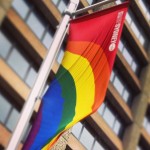Science and homosexuality: Why your genes are just so gay
By: John Pickrell

Since the realisation that I was attracted to men in my early adolescence, I’ve never had any doubt that the desire was entirely innate and immutable.
I’ve never been attracted to women, and I couldn’t imagine feeling any other way. Not everybody attracted to the same sex feels this way, however. A minority of gay men, and – according to psychologists, such as Lisa Diamond at the University of Utah – certainly many gay women, feel that their sexual orientation is something more fluid and malleable; something that can change, can be shaped by experiences, and is intensified by attachment.
Over the past two decades, there have been many studies that together reveal a strong biological component to being gay (I use the term ‘biological’ instead of genetic because, although the trait is innate, it is not explained by genes alone).
Others suggest that homosexuality serves a useful evolutionary purpose – more on that later. The overall picture of sexual orientation is complex and different factors may be at play in different people.
I have friends, for example, who are identical twins: they possess the same genes and had the same upbringing, but only one of them is gay. There may be a significant genetic component to being gay, but it’s not the whole picture, and is unlikely to be reduced to anything as simple as a single gene. There is an argument that the search for a ‘gay gene’ would be bad for the gay rights movement, because it could lead to parents aborting ‘gay’ foetuses. In fact, I believe the search for the biological basis for being gay is essential if we are to understand the basic nature of our humanity.
Unfortunately, at least for the moment, most of the studies looking into the genetics of homosexuality are about men, not women. There could be an element of sexism to the bias of this research, but it also could be that it’s more difficult to reduce female same-sex attraction to a simple number of factors. Some studies suggest that male same-sex attraction is about 40 per cent genetic, while the genetic component of female same-sex attraction is perhaps 25 per cent.
Whatever the basis for homosexuality, we know it is hard-wired into our bodies and not purely psychological. The first study to find structural difference between the brains of gay men and straight men was published in 1991 by researchers including American neuroscientist Simon LeVay, who has since gone on to write a series of books on the biology of sexual orientation. In 2008, a larger study from the Stockholm Brain Institute in Sweden scanned the brains of 90 people and found that although the gay men and straight women tended to have symmetrical brains, lesbians and straight men tended to have asymmetrical brains, with left hemispheres that were significantly smaller than right ones. These results built on earlier studies that seemed to show that some gay men and straight women had better language skills (left hemisphere), while some straight men and lesbians had better senses of direction (right hemisphere).

Images: Marina Bonofiglio
The first study to reveal a genetic component to being gay was published in 1993 and led by geneticist Dean Hamer at the National Cancer Institute in the USA. His team revealed that a region of the X chromosome – labelled Xq28 – was likely to be shared by brothers who were both gay. A 2014 study, presented at a conference in Chicago in February, looked at 400 pairs of twins. It backed up the role of this gene region, finding that it could explain about 40 per cent of the chance of a man being gay.
“Sexual orientation has nothing to do with choice. Our findings suggest there may be genes at play – we found evidence for two sets that affect whether a man is gay or straight,” lead author Michael Bailey, of Northwestern University in the USA, told the UK’s The Telegraph newspaper. “But it is not completely determinative; there are certainly other environmental factors involved.”
No such genes or gene regions as Xq28 have yet been found for gay women, but we know there is a genetic component because of patterns of homosexuality in identical twins. Some of the best evidence that being gay is partly genetic comes from twins. Identical twins (where both have the same set of genes) are much more likely to both be gay than non-identical twins (where they are only as related as any brother or sister, sharing about half their genes). This strongly suggests there’s a genetic element to being gay, but it doesn’t account for the entire picture; when one identical twin is gay, only in about 20–50 per cent of cases is the other twin also gay.
So if genetics doesn’t account for the whole picture, what other factors are at play? This is where the complex world of ‘epigenetics’ comes in. Our DNA is not the only factor in deciding whether our genes are expressed or not. The way our DNA is packaged up into bundles and packed away within our cells also determines whether genes are hidden away or available to play an active role in our bodies. In effect, genes can be switched on or off – a phenomenon known as epigenetics. It may be the genes that account for same-sex attraction could be switched on by an environmental effect (‘environment’ in this context could be the womb or your upbringing; it could be chemical or psychological). This may mean certain people have the genetic propensity to be gay, but may or may not encounter the environmental conditions that cause that trait to be switched on.
Researchers led by William Rice, at the University of California, published a study in 2012 arguing that epigenetics could be a major factor in explaining both male and female homosexuality. The researchers believe that so-called ‘epigenetic marks’ – a kind of annotation on top of DNA – control how susceptible foetuses are to hormones in the womb. For example, some male babies are made much more susceptible to the effect of maternal hormones than others, and are not able to develop fully masculine traits. This could account for why one of a pair of identical twins ends up being gay, while his brother is straight.
Other research points to hormonal and chemical processes in the womb as having an effect on sexual orientation. Perhaps the best known is a theory labelled the ‘fraternal birth order effect’. A string of studies seem to show that men with many older brothers are more likely to be gay. This is certainly biological and not social, as it’s not seen in cases of younger brothers with older adopted siblings.
Scientists behind these studies suggest that fraternal birth order is the cause of same-sex attraction in about 15–30 per cent of gay men. There’s a certain irony in these statistics, because it means that gay men are more likely to be born into the families of religious conservatives, who may or may not have a problem accepting them, as these families are more likely to have large numbers of children.
A possible explanation for the birth order effect has been put forward by Ray Blanchard, at the University of Toronto in Canada. His work suggests that male foetuses produce a male-specific ‘masculinising’ antigen in the womb, which a woman’s immune system rallies against (anitgens are chemicals foreign to the body that elicit an immune response). With enough antibodies from the mother, this antigen is neutralised and the male foetus is no longer capable of producing a straight-male sexual orientation. As a woman has more male children, she produces more and more of these antibodies during pregnancy, thus making it more likely the child will become gay.
Some gay equality activists have a problem with this scenario, with its implicit assumption that same-sex attraction is a developmental defect which could potentially be corrected in the womb. But these activists are missing the point: whether being gay is caused by genetic effects, epigenetic effects or the environment of the womb, it may still have evolutionary benefits.
Evidence is building that homosexuality is not an accident and that it serves a useful evolutionary purpose, whatever the biological basis behind it. A 2008 study showed that male homosexuality occurs at low, but stable frequencies across many different human societies, suggesting it is not present by chance alone.
More than 450 different species of animal, from penguins to giraffes, have been shown to exhibit gay behaviour, or form gay pairings. Many studies, such as one from the University of California, have argued that these behaviours offer benefits to a species.
There’s plenty of evidence that homosexuality may play a useful role in humans, too. This is either because the genes responsible for same-sex attraction are linked to other useful reproductive traits, or because gay men and women play an important role in societies, which benefits the group as a whole, increasing the overall rate of reproduction.
Some experts have suggested that – at least historically, in hunter-gatherer societies, where the complement of genes we possess today was largely built – gay aunts and uncles may have assisted their siblings in the care of children, even if they didn’t reproduce. In this scenario, the gay aunts and uncles are still winners in the evolutionary sense, as they share many genes with the offspring of their siblings, and the family group produces more offspring overall as a result.
“The gay uncle theory, where you look after your nephews and nieces…makes sense in a wild ancestral human,” says Richard Dawkins, an Oxford University evolutionary biologist. You can imagine a scenario in which the straight men go out hunting, leaving the otherwise vulnerable children in the care of these gay men, says Dawkins, adding, “the gay gene was passed on in the bodies of the children who were being protected.”
Dawkins is also an advocate of what he calls the ‘sneaky fucker’ theory, or “the idea that [many of] the males who possessed the homosexual ‘gene’ may have been bisexual”. He says that while the dominant males in hunter-gatherer societies may have trusted their women in the care of these men, the gay males may have occasionally had sex with the women, fathering some of their children.

Images: Marina Bonofiglio
There have also been some interesting studies that seem to show that genes which cause a brother to be gay might lead his sister to have a larger-than-average number of children. For example, a 2004 study from the University of Padua in Italy (which involved 98 gay men and 100 straight men) found that the female relatives of gay men were likely to have more offspring than the female relatives of straight men.
This ‘sexy sister’ hypothesis suggests these women are reproductively successful enough to discount the fact that their brothers don’t have offspring. It’s also very possible that the genes that make lesbians attracted to women have a reproductive benefit for their brothers, but this is yet to be found by scientists.
A twist on the ‘sexy sister’ idea came from researchers led by Brendan Zietsch at the Queensland Institute of Medical Research in 2008. His team argued that the male siblings of gay men may benefit from a number of genes that partially feminise their behaviour, making them more empathic, agreeable and caring. This made the straight male sibling more attractive to women, leading to a larger number of sexual partners. For their gay brothers, Zietsch suggested, the feminising effect was too great, leading them to be attracted to men instead of women.
The overall conclusion here is that the biological factors that cause homosexuality in men and women very likely have a genetic component, but these are varied and complex. Following the 2014 study on the Xq28 chromosome region, a spate of opinion pieces argued that the search for a ‘gay gene’ was folly, and could potentially set the gay equality movement back if tests were developed to diagnose ‘gay’ foetuses. For example, Alex Andreou, a columnist for The Guardian, wrote: “That a single cent of medical research should be devoted to explaining whom I choose to share my bed with, is utterly obscene.”
This is a head-in-the-sand approach. The pursuit of all knowledge is valuable, particularly when it helps us to understand the very basic nature of our shared humanity. It’s akin to arguing that we shouldn’t have strived to understand the structure of the atom because it led to the development of nuclear weapons. It’s not the knowledge itself that’s a dangerous thing, but what people choose to do with it.
The fear of the development of a diagnostic test for ‘gay’ foetuses is over-exaggerated, because it’s likely the genes only account for the propensity to be gay – one that requires environmental and other factors for it to be realised. This means that any diagnostic test would have a very poor chance of predicting a gay child. Would conservative or homophobic parents be prepared to abort a foetus when there’s a 70 per cent chance it will be straight? It remains to be seen. There’s also the point that many conservatives are against the concept of abortion, in any case.
There’s also very little chance of homosexuality ever being removed as part of the human evolutionary landscape, because it’s likely that it is passed on by heterosexual siblings, for whom it confers a reproductive advantage. Homosexuality is here to stay, and I for one am very keen to understand the genetic and biological basis behind it.
John Pickrell is an award-winning science writer. He has worked in London, Washington DC and Sydney for publications including New Scientist, Science, Science News and Cosmos. More of John’s articles can be found online and in print at National Geographic, Scientific American and the ABC. He is also the editor of Australian Geographic magazine. Follow him on Twitter: @john_pickrell














Slave to the binary! Sexuality is a spectrum and people sometimes move around on this spectrum during their lives. Many sit at either end and don’t move, lots defy description. I found this piece an old school and lazy cobble job!